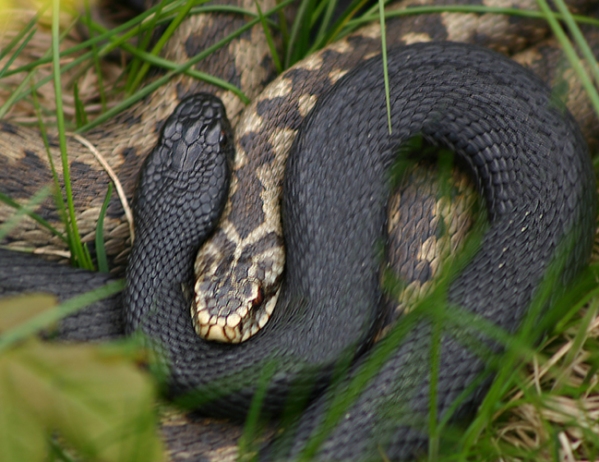I hadn’t planned on writing about adders today. But I was looking for cool pictures of rattlesnakes to draw, and came across a lovely picture of an adder’s face. Before I knew it, I had started drawing, and so the subject of today’s blog post was chosen. So it goes.
Common adders are found in a large area, from the UK in the west to the China and Korea in the East. They are notable for being found further north than any other species of snake, and are also the only venomous snake species the UK. As you can imagine for such a widespread animal, they live in many different types of habitats. They are known to inhabit woodlands, hills, moors, meadows, grasslands and wetlands. Adders do require spots suitable for sunbathing, as well as ground cover so they can hide from predators.

Adders are reasonably large snakes, reaching lengths of up to 80 cm. They vary in colour, and can be grey, cream, pale yellow or reddish brown. Most adders have some kind of zig zag pattern on their backs and sides, though some snakes are entirely black and so have no visible pattern at all. Female common adders tend to be bigger than males, and have more reddish colouring.
Activity in adders varies depending on their location — in the north they tend to be most active during the day, while in the southern part of their range they come out at in the evening or at night. Cold-blooded animals don’t do so well when temperatures drop below freezing, so adders in colder areas hibernate during the winter. They hibernate in groups, drawing warmth from one another, as well as from the burrows they sleep in. Even with these precautions, not all snakes survive the winter: 15% of adults and 30-40% of juveniles will not make through hibernation.

Common adders are venomous, but they aren’t particularly scary snakes. Their venom isn’t super deadly to humans, with only intense pain and swelling occurring at the bite site. It is very rare for humans to die from common adder bites, with the most vulnerable population being small children. These snakes are also quite shy — they prefer to run away rather than bite. However, they are quite common in human inhabited areas, so bites aren’t that uncommon, and medical treatment is required after each bite. On the bright side, there is plenty of antivenin available!
Their venom may not be super effective against people, but it works pretty well on the snakes’ preferred meals. Adders will either wait to ambush prey while it walks by, or actively hunt an animal using their keen sense of smell. Mice, voles, shrews, lizards, birds and frogs all fall victim to common adders. Adders themselves fall prey to foxes, badgers, and birds of prey. Their colouration helps them hide, and any potential predator does have to be wary of the snakes’ bites.

After spending a long winter curled up with other snakes, adders emerge in a pretty good mood. They start to mate soon after coming out of hibernation, in the spring. Male snakes wait patiently for females to emerge, and then try and convince them to engage in copulation. They do this by relentlessly following females, for hundreds of meters if need be. When they do catch up to a lucky girl snake, the males will flick their tongues along her back and lash their tails excitedly. They also have to chase away any rival males, and fights do sometimes occur.
Females give birth to three to twenty young, after a three to four month gestation period. The young snakes are fourteen to 23 cm long, and are born in a sac that they must emerge from. They also have a yolk sac that they can use for nutrients during the first few days of life. This is important, as the young snakes are independent from birth. They take three to four years to reach sexual maturity.
Despite their large range and hefty population, adders are a protected species in some countries, such as Britain and Norway. Thanks to habitat fragmentation, human fear of the species, and collection for pets, adder populations are declining. It’s a shame because these are some lovely snakes, despite their venom. Yes, I wouldn’t want to get bitten by an adder, but the same rule applies to adders as to all snakes: leave them alone, and likely you won’t have any trouble. So don’t go pestering these pretty guys!
Cover image by Zdeněk Fric (fric@entu.cas.cz), CC BY-SA 3.0, via Wikimedia Commons
